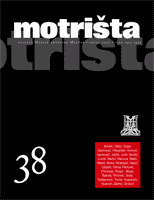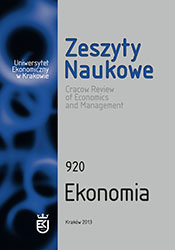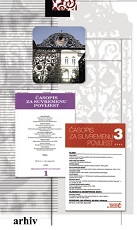











Keywords: economy; macroeconomics; social product; balance on the market of production factors; unemployment; inflation; macroeconomic balance; business cycle
The review concerns a textbook for the study of macroeconomics at economics and non-economics institutions alike. This publication corresponds to canons of contemporary macroeconomics in terms of both theories and the forms in which they are presented. In a competition held by the National Board of the Polish Economic Society, the book received the award for the best textbook published in Poland in the years 2009–2011.
More...
Keywords: capital; growth model; economic constant; limits to growth
The article presents the capital growth model created by M. Dobija (2007), concentrating on one of its most important components ‒ the economic constant of the potential growth of capital. It then looks at the most convincing corroboration of the existence of this constant, namely research conducted by B. Kurek (2007). Presenting this research in the context of the history of economics and economy as a whole allows the author to show that there is insufficient evidence to grant the assumptions which led Dobija and Kurek to conclude that such an economic constant exists. The author concludes that limits in the past as well as in the future should disallow economists from stating that such a constant exists.
More...
Keywords: financial crisis; economical model; interventionism; liberalism
This paper gathers different views of economists on the causes and effects of financial crises. It also examines the position of professors of economics on the path chosen by contemporary economics. The article briefly discusses the causes of the global economic crisis of the 21st century, running them through Hyman Minsky’s model. It also looks at the effects of the crisis along with the actions taken by different institutions in response to the crisis. The main purpose of the paper is to look closer at theoretical views and arguments presented by economists including Hyman Minsky, Paul Krugman, Charles Kindleberger, and Joseph Stiglitz.
More...
Keywords: risk; diversification; Neumann-Morgenstern model; expected utility; investor
Proper risk management ‒ based on the theory of behavioural finance ‒ will lead a rational investor to make the right choice preferences while estimating the minimal level of risk and receiving the greatest rate of return. One of the effects of risk management is diversification, which is also one of the main means of reducing the global level of risk. Diversification also contributes significantly to improving the long-term rate of return on an investment. Different utility functions are related to the tendency of investors to connect the level of risk and diversification with the level of expected revenue. The maximising utility is proportional to the value of money. Risk management and diversification agree with the John von Neumann and Oskar Morgenstern model.
More...
Keywords: operational risk; measurement methods; Basel Committee on Banking Supervision; Key Risk Indicators
The number of well-known firms joining the list of entities such as Enron, WorldCom, Sumitomo Corp., all of which lost millions of dollars as a result of inadequate operational risk management systems, increases dramatically with each passing year. This has increased the amount of interest in this marginalised aspect of risk. The quantitative estimation and measurement of operational risk proved necessary with the implementation of new operational risk management strategies in companies and financial institutions. Basel Committee on Banking Supervision recommendations, which request banks to use quantitative methods in their operational risk management are an additional motivation to use quantitative methods of estimating operational risk. This article reviews the most important quantitative methods of estimating and measuring operational risk.
More...
Keywords: business cycles synchronisation; spectral analysis; emerging economies; decoupling hypothesis
The paper discusses the viability of the decoupling hypothesis, which states that the performance of emerging economies becomes relatively independent from the changes in developed economies, and empirically verifies this hypothesis in the light of global economic developments over the past decade. Despite a very influential paper by Kose, Otrok, and Prasad (2008), we argue that there is no evidence that decoupling between developed and emerging economies took place before the last global financial crisis. In fact, the case was quite the contrary ‒ ties between the two groups of countries strengthened during the crisis years. It seems that either decoupling never took place or the recent crisis began a new trend of re-coupling, which is the instance of emerging economies returning to a state of strong dependence on their more developed counterparts. At the same time it raises doubts as to whether the high rates of growth in emerging economies can be sustained in the face of slowing growth in developed economies. In terms of methodology, linear and quadratic de-trending were used to obtain stationary data, then non-cyclical movements were removed with the Christiano-Fitzgerald band--pass filter. The cyclical parts of real GDP time series were then subjected to spectral and co-spectral analysis.
More...
Keywords: case study; business education; human capital; education system
Review of the book “Metoda studium przypadku w edukacji biznesowej”, ed. P. Ammerman, A. Gaweł, M. Pietrzykowski, R. Rauktienė, T. Williamson (Bogucki Wydawnictwo Naukowe, Poznań 2012) Recenzja książki „Metoda studium przypadku w edukacji biznesowej”, red. P. Ammerman, A. Gaweł, M. Pietrzykowski, R. Rauktienė, T. Williamson (Bogucki Wydawnictwo Naukowe, Poznań 2012) The text is a review of the book Metoda studium przypadku w edukacji biznesowej [The case study method in business education], which is a summary of the project “Transfer of experiential and innovative teaching methods for business education” done under the auspices of The Leonardo da Vinci programme. The author of the review discusses the book, pointing out among its advantages a presentation of the case study method as an innovative tool for economic education that combines theory and practice by focusing on the personal and practical dimension of education. He also recognises its disadvantages, which include the failure to present the method’s weaknesses, due to a lack of reflection on the meaning of case study methodology in the context of the functions and tasks facing universities.
More...
Keywords: foreign policy; war; macroeconomics; econometrics
The research described in the paper explores the links between political and economic processes. The correlation was detected at the international level in the politics and economics of the United States. U.S. foreign policy viewed in terms of the military constitutes the political process, while the economic process is the macroeconomic situation in the U.S. economy. Political events and economic phenomena are presented in the shape of cycles, which are then examined in terms of correlations: first intuitively and perceptually, then econometrically.
More...
Keywords: Croatian cultural society "NApredak"; Branches in Croatia; scholarship foundation
The article presents organization and activities of the Sarajevo based Croatian cultural society "Napredak" in Croatia from its foundation in 1902 to 1941.
More...
Keywords: European Union; harmonizing a value added tax; tax systems
The article gives a historical presentation of the value added taxation system in Europe.
More...